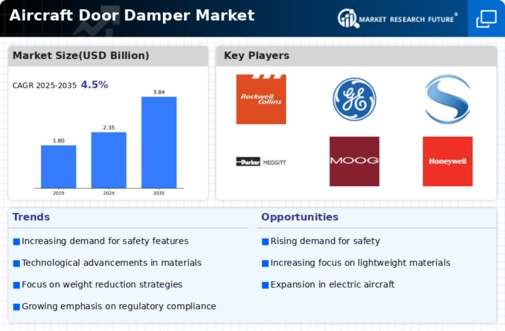Market Trends and Projections
The Global Aircraft Door Damper Market Industry is poised for growth, with projections indicating a market value of 2.35 USD Billion in 2024 and an anticipated increase to 3.84 USD Billion by 2035. The compound annual growth rate (CAGR) is estimated at 4.56% from 2025 to 2035, reflecting the industry's resilience and adaptability. Key trends influencing this growth include advancements in technology, regulatory compliance, and the expansion of the aerospace sector in emerging markets. These factors collectively contribute to a dynamic market landscape, where innovation and safety remain paramount.
Increasing Demand for Aircraft Maintenance
The Global Aircraft Door Damper Market Industry is experiencing heightened demand for aircraft maintenance services, driven by the growing fleet of commercial and military aircraft. As airlines and defense organizations prioritize safety and reliability, the need for effective door dampers becomes paramount. Maintenance schedules often require the replacement or servicing of door dampers to ensure optimal performance. This trend is reflected in the projected market value, which is expected to reach 2.35 USD Billion in 2024. The emphasis on maintaining aircraft integrity and performance is likely to propel the demand for advanced door damper technologies.
Regulatory Compliance and Safety Standards
The Global Aircraft Door Damper Market Industry is significantly influenced by stringent regulatory compliance and safety standards imposed by aviation authorities worldwide. Organizations such as the Federal Aviation Administration (FAA) and the European Union Aviation Safety Agency (EASA) mandate rigorous testing and certification processes for aircraft components, including door dampers. Compliance with these regulations ensures that manufacturers produce reliable and safe products, thereby enhancing market credibility. As the industry adapts to evolving safety standards, the demand for high-quality door dampers is likely to increase, further driving market growth.
Technological Advancements in Aircraft Components
Technological innovations are reshaping the Global Aircraft Door Damper Market Industry, with manufacturers focusing on developing more efficient and durable dampers. Advancements in materials science, such as the use of lightweight composites and advanced polymers, enhance the performance and longevity of door dampers. These innovations not only improve operational efficiency but also contribute to weight reduction in aircraft, which is a critical factor in fuel efficiency. As a result, the market is anticipated to grow at a CAGR of 4.56% from 2025 to 2035, reflecting the industry's commitment to integrating cutting-edge technologies into aircraft design.
Growing Focus on Fuel Efficiency and Sustainability
The Global Aircraft Door Damper Market Industry is increasingly aligned with the aviation sector's focus on fuel efficiency and sustainability. As airlines strive to reduce operational costs and environmental impact, the integration of lightweight and efficient door dampers becomes essential. These components play a crucial role in minimizing drag and enhancing overall aircraft performance. The industry's shift towards sustainable practices is likely to drive innovation in door damper design, leading to more eco-friendly materials and manufacturing processes. This trend is expected to support the market's growth as stakeholders prioritize sustainability in their operational strategies.
Expansion of the Aerospace Sector in Emerging Markets
Emerging markets are witnessing substantial growth in the aerospace sector, contributing to the expansion of the Global Aircraft Door Damper Market Industry. Countries in Asia-Pacific and Latin America are investing heavily in their aviation infrastructure, leading to an increase in aircraft orders and deliveries. This expansion necessitates the incorporation of advanced door dampers in new aircraft models. As these regions develop their aviation capabilities, the market is expected to see a notable increase in demand, aligning with the projected market value of 3.84 USD Billion by 2035, indicating a robust growth trajectory.
























Leave a Comment